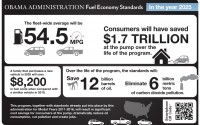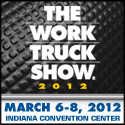
| Monday, November 21, 2011 | Archives | Advertise | Online Buyer's Guide | FLEETSolutions |
Five Ways Parts, Technology Can Help Automakers Meet 2025 CAFE Standards
 Automakers have approximately 5,000 days until U.S. Corporate Average Fuel Economy standards are expected to tighten to nearly fifty-five miles per gallon. In that time frame, companies are expected to make significant changes to their vehicle fleets, including increasing production of hybrids and incorporating more fuel efficient techniques in traditional internal combustion engines. Automakers have approximately 5,000 days until U.S. Corporate Average Fuel Economy standards are expected to tighten to nearly fifty-five miles per gallon. In that time frame, companies are expected to make significant changes to their vehicle fleets, including increasing production of hybrids and incorporating more fuel efficient techniques in traditional internal combustion engines.Those new technologies and techniques that are developed may not come directly from the automakers, according to Bosch LLC President, Chairman, and CEO Peter Marks. Marks, along with a dozen or so other executives, spoke on November 8 at the company’s Automotive Electronics Division in Plymouth about how their technology advancements – from engine components to GPS technology – can help automakers achieve the 2025 CAFE standards. While many consider the new CAFE regulations ambitious, the company is taking a proactive approach and looking at how each component of a vehicle can be tweaked to increase fuel economy and decrease CO2 emissions. Besides turning every vehicle into all-electric vehicles or hybrids, which on average remain $5,000 more than traditional internal combustion engines, how will automakers meet the standards? Automotive executives agree that the future of the automotive industry is a mixture of new technologies combined with the internal combustion engine. Clean diesel engines - While U.S. consumers have been slow to accept diesel engines, Bosch says almost one out of every three Americans now consider buying diesel, and more than one-third of consumers who are offered a diesel option purchase one. Chrysler Group LLC and General Motors Co. are expected to release new diesel models in two years. By 2020, analysts predict diesels will be ten percent of the U.S. market. Start/stop systems - A relatively simple process that some automakers are already using. The engine shuts off when it is not needed. A simple start/stop system, which shuts the engine off when the vehicle is stopped, can improve fuel economy 2-3 percent; and future advanced engine start/stop models, which shuts off the engine when stopped as well as when coasting, are believed to increase fuel economy by ten percent. A stop-start system automatically shuts down and restarts the internal combustion engine to reduce the amount of time the engine spends idling, thereby improving fuel economy and reducing emissions. Direct injection engines - Gasoline direct injection engines are projected to increase thirty-nine percent to 6.3 million units, even with the burgeoning electric vehicle market in place. Port fuel injection systems combined with other available technologies, such as start/stop systems and turbocharging, can increase an engine’s fuel efficiency by nearly fifteen miles per gallon. The gasoline in direct injection internal combustion engines is highly pressurized, and injected via a common rail fuel line directly into the combustion chamber of each cylinder, as opposed to conventional multi-point fuel injection that happens in the intake tract, or cylinder port. Electric power steering - The electrification of vehicles is expected to play a major role in improving fuel efficiency to meet the CAFE standards. But one element that not many may have heard about is electric power steering "guiding" the way to help a vehicle’s fuel efficiency. Electric power steering is a catalyst for fuel efficiency and advanced technology, such as driver drowsiness detection, throughout a vehicle. Vehicles such as the Chevrolet Volt and Equinox, GMC Terrain, and Buick LaCrosse and Regal all use EPS technology. Dashboard technology, including GPS and driver monitoring - One of the simplest ways to save gas and improve fuel economy is educating drivers with dashboard technology. Technology in a vehicle, as seen in many hybrid models, can also track a person’s driving habits to better educate them on when they should be coasting and the best times to use cruise control. |
 |
NAFA Fleet Management Association 125 Village Blvd., Suite 200 Princeton, NJ 08540 Telephone: 609.720.0882 Fax: 609.452.8004 |








